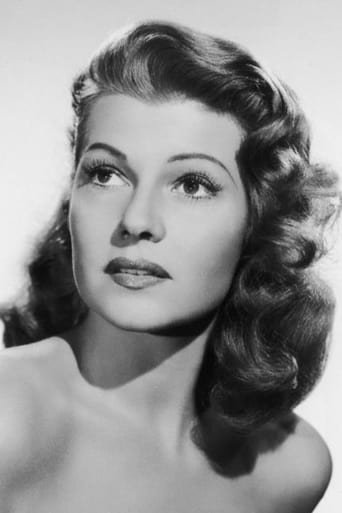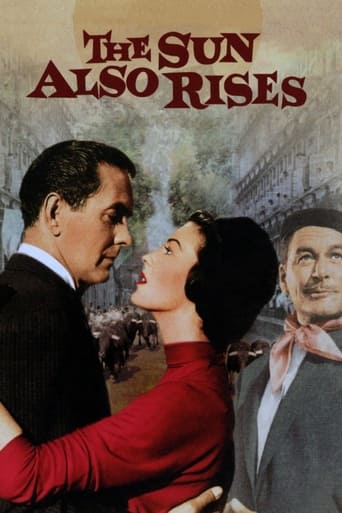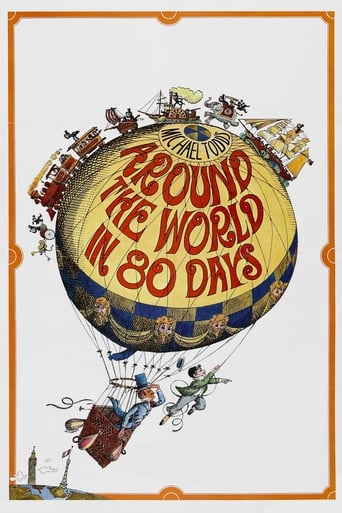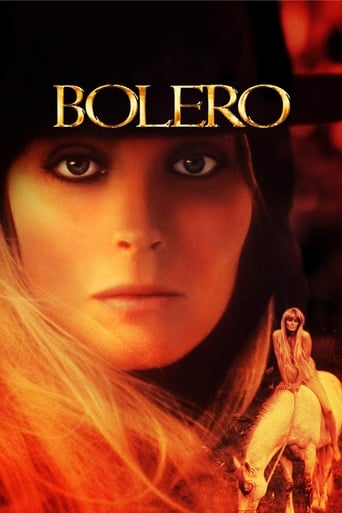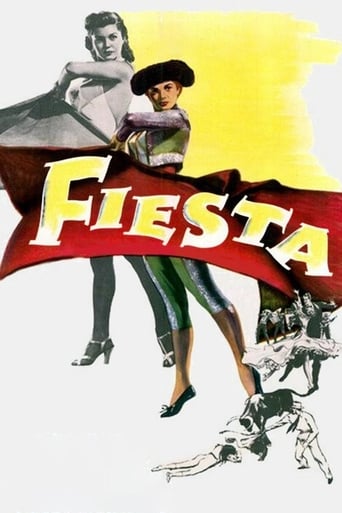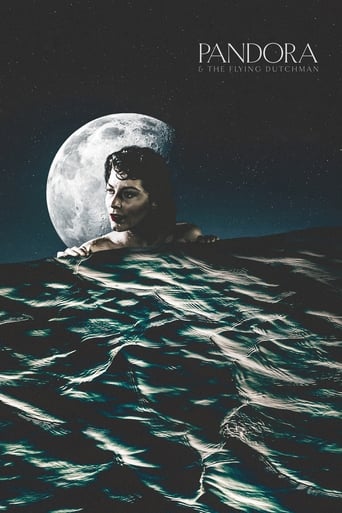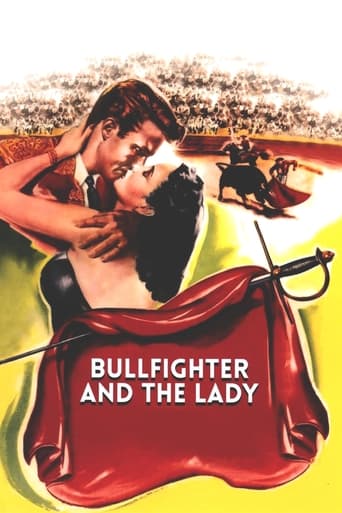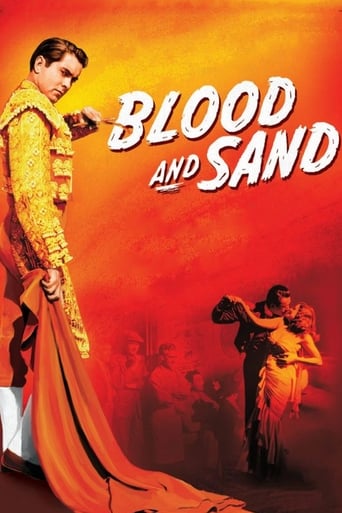

Blood and Sand (1941)
Bullfighter Juan Gallardo falls for socialite Dona Sol, turning from the faithful Carmen who nevertheless stands by her man as he continues to face real danger in the bullring.
Watch Trailer
Cast


Similar titles
Reviews
I didn't use to like Tyrone Power. I saw him in The Eddy Duchin Story, Untamed, and In Old Chicago, and thought that was all he could do. If I'd seen him in The Black Swan, The Long Gray Line, and Blood and Sand instead, I probably would have thought he was great. He stars as a matador in Blood and Sand, and while he sometimes doesn't make the best choices, he channels a young George Clooney and makes the audiences root for him.The movie starts out when he's a young kid, dreaming of becoming a bullfighter. This part of the story isn't very interesting because he's made out to be a bit of a scoundrel. He sneaks out of the house past curfew, lies to his mother, steals cigars and alcohol, and gives attitude to adults. When he grows up and becomes Tyrone Power, he's more likable. He woos the beautiful and sweet Linda Darnell and pursues his dream of becoming a famous and respectable bullfighter. But with a fickle critic, Laird Cregar, a rival from childhood, Anthony Quinn, and a sleezy seductress, Rita Hayworth, he has a difficult road ahead of him.I'm really not a Rita Hayworth fan, and I always find it incredibly difficult to understand why she was cast in roles where she's supposed to be beautiful and wildly attractive. The good news is Linda Darnell is very easy to root for. She's beautiful and devoted, and she and Tyrone look great together. Speaking of looking good, even though Blood and Sand isn't a classic I'll probably rent again, it was pretty entertaining since the two good-looking leads spent virtually the entire movie prancing around in very tight matador costumes. Ladies, if your sweetie-pie likes bullfighter movies, you might want to suggest this one so you can both have a good time!
It is often supposed that silent pictures are the more stylised, elegant and wordless medium when compared to their talkie counterparts, but this is not always the case. Silent movies could sometimes be clunky and overly blunt in their expression, and there were many visually graceful sound pictures. This 1941 version of Vincente Blasco Ibáñez's novel Blood and Sand, previously filmed as a silent in 1922, is a case in point.The first thing that strikes you about Blood and Sand is its breathtaking look. The Oscar-winning Technicolor cinematography of Ernest Palmer and Ray Rennahan brings layers of texture to even the dark shape of the bull's head in the opening scene, and picks out smooth whites like sculpted cream. Even the day-for-night filming (usually awful in early colour movies) doesn't look too bad. Then there is the glorious production design of Richard Day, Joseph Wright and Thomas Little which, rather than dazzling us with the array of shades available in three-strip Technicolor, sticks to two main colours – a rich dark blue and a sandy brown, both gorgeous tones which complement each other – and the story's natural surroundings – perfectly.Orchestrating these colours is director Rouben Mamoulian. Mamoulian was far more interested in style and appearance than he was in story or drama, and this is forgivable because by this point he did style better than almost anyone else in Hollywood. He uses those two tones – the blue and the brown – to regulate the colour temperature, carefully arranging props, players and camera so that the different shades flow on and off the screen. See how for example the young Gallardo creeps through the cold blue of the town, into the warm glow of the tavern, a woman in a yellowy-brown dress dancing into the centre of the screen. The movements of the actors are not only there for theatrical expressiveness (although there is that), but they also help to shift the colours around – Linda Darnell pulling up her shawl to bring total gloom to the chapel, or a blue curtain being pulled back to reveal a rack of golden matador outfits.However, speaking of theatrical expressiveness, Mamoulian did like to encourage such flamboyance from his cast. Tyrone Power, Linda Darnell and Rita Hayworth, big stars as they were, were not really great actors, but that's OK because all they are really required to do here is fill particular types. Power need be little more than a tower of swaggering masculinity, Hayworth need only be coolly alluring, and so on. The immense theatricality of the supporting cast is itself a boon. Only a director like Mamoulian would think of something so brilliantly corny as having the mortally wounded Nacional below a crucifix, his outstretched arms mimicking the Christ position, but it takes a grand old ham like John Carradine to make the pose look fitting.However, the area in which this version of Blood and Sand best distinguishes itself above its silent predecessor is in its writing and structure. The 1922 picture was in fact very stylishly directed by the great yet unsung Fred Niblo, and was superbly edited by a young Dorothy Arzner. However, it was extremely wordy (as in lots of intertitles) and contained much of the preachiness of the novel as well as one or two awkward subplots. The screenplay for 1941 on the other hand, written by the accomplished Jo Swerling, is a model of balance and succinctness. The inclusion of Gallardo's beginnings as a teenage wannabe are a good trade-in for the meanderings of the silent version, and they fully flesh out the rise-and-fall story arc. A couple of reminders of these early days towards the end of the picture add to the poignancy of the finale. This Blood and Sand is also complemented with many long wordless sections – the young Gallardo's bullfight in the dark, Dona Sol's hypnotic guitar performance (and later some genuine guitar playing by Vincente Gómez) and Hayworth's provocative dance with Anthony Quinn. Eventually, the picture begins to take on an intense, operatic quality, in which words become transcended by images. It is a full expression of cinema as a visual medium.
20th Century Fox's 1941 production BLOOD & SAND is a remake of the 1922 silent classic that established Rudolph Valentino as the greatest star of early cinema. Beautifully photographed in vivid 3 strip Technicolor by Ernest Palmer and Ray Renahan the elaborate newer version had the obvious heir-apparent to the silent screen star in dashing Tyrone Power. Written for the screen by Jo Swerling from the novel by Vicente Blasco Ibanez it was directed with a certain amount of flair, it has to be said, by Rouben Mamoulian who just the previous year had had his greatest success with Tyrone Power when he directed him in the classic "Mark Of Zorro"BLOOD & SAND recounts the story of a young, ambitious and quite naive bullfighter Juan Gallardo (Power) who falls under the spell of a beauteous and attractive socialite (Rita Hayworth) wrecking his relationship with Carmen (Linda Darnell) the girl who has always loved him since childhood. The picture culminates with Juan discovering too late that he is only a toy for the manipulative socialite. And finally in the end when he is gored by a bull in the ring it is the forgiving Carmen, his only true love, that comes to his side to comfort him as he lays dying.BLOOD & SAND was a very popular picture of the War years and remains a great favourite with Power devotees. However I have to confess to never being very fond of it. There is little doubt Ty Power is good as the aspiring Matador and Hayworth chews up every bit of scenery in sight as the alluring Donna Sol. But with the exception of Anthony Quinn and that memorable dance sequence he does with Hayworth I found the rest of the cast - particularly the young actor Rex Downing who played Juan as a boy - unconvincing and altogether uninspiring. In fact the whole picture for me was curiously uninvolving! Also Juan being gored by the bull towards the end is very badly done! You don't really see what happens to him. Was he gored in the back or the front? It is very difficult to decipher. And he appears very clean and unmarked in his ensuing death scene.Nevertheless the great Alfred Newman saves the day with his terrific score. Besides his music capturing all the heat, dust and passion of the bullring the composer also incorporates into his score the sumptuous traditional Spanish guitar melody "Romance D'Amour". An engaging and totally ravishing piece that was used to greater effect in "Forbidden Games" in 1952 when it was played by guitar genius Narciso Yepes.BLOOD & SAND can at least be enjoyed for its awesome colour Cinematography, Newman's great music, the star power and presence of Tyrone Power and the flowing beauty of Rita Hayworth.
Uneducated peasant Juan Gallardo rises to fame and fortune in the bullfight arena. From here he falls for the socially active Dona Sol; thus breaking the heart of his childhood sweetheart Carmen. Nevertheless she stands by her man as he continues to face danger in the bullring, but ego and love will give Juan his biggest fight of all.This remake of the 1922 silent Rudolph Valentino picture is certainly a lavish production, the colour cinematography by Ernest Palmer & Ray Rennahan rightly won the Academy Award, and it's directed with adroit skill by Roublen Mamoulian. The story is a great one as well, following the rise of Gallardo (a solid if too staid Tyrone Power) is always intriguing, and it's watching his constant battle with his emotions that is the film's drawing card. However, there can be a case made for the film resting too much on its dialogue driven laurels, for far too many times I personally found myself hankering for an up turn in pace to help emphasise the emotional nature of the characters.The cast do OK without really excelling, Rita Hayworth looks gorgeous and a fine career blossomed from here on in, while Linda Darnell as the other love interest glides nicely from scene to scene. Anthony Quinn takes the best supporting honours, where his Manolo is vigorous with a cheeky glint in the eye, whilst sadly John Carradine is underused and his Nacional is not fully fleshed out until its far too late.It's at times sexy (damn flamenco always a winner to me), it's got guts, and it looks absolutely gorgeous, but it's not quite the whole classy package it could have been. 7/10




